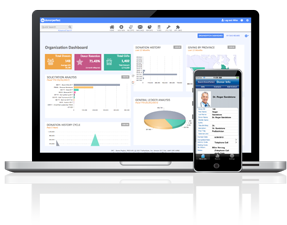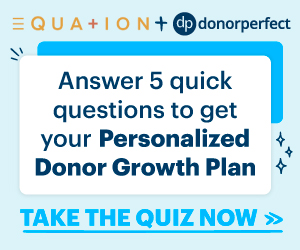Speaking as a nonprofit consultant, there is both a legal answer to this question provided by the IRS and a practical answer to this question in terms of building a relationship with your donors. I highly recommend nonprofits acknowledge ALL contributions in the form of a letter. While legal, email acknowledgments are impersonal and show little respect to the donor. Below is a wealth of information that outlined the responsibilities of both the nonprofit organization and the donor concerning charitable contributions.
IRS Publication 1771 (Charitable Contributions- Substantiation and Disclosure Requirements) explains the federal tax law for 1) organizations such as charities and churches that receive tax-deductible charitable contributions and 2) taxpayers who make contributions.
There are recordkeeping and substantiation rules imposed on donors to charities, while charities that receive certain quid pro quo contributions follow disclosure rules. These laws stipulate that:
- a donor must have a bank record or written communication from a charity for any monetary contribution before the donor can claim a charitable contribution on his/her federal income tax return.
- a donor is responsible for obtaining a written acknowledgment from a charity for any single contribution of $250 or more before a donor can claim a charitable contribution on his/her federal income tax return.
- a charitable organization is required to provide a written disclosure to a donor who receives good or services in exchange for a single payment in excess of $75.
Donations involving a motor vehicle, boat, or airplane that has a value that exceeds $500 are handled differently. For more information on vehicle donations, see IRS Publication 4302, A Charity’s Guide to Vehicle Donations, and IRS Publication 4303, A Donor’s Guide to Vehicle Donations.
The IRS has not created a standard format for contribution receipts, but the following information must be included:
- The donor’s name.
- The amount of money or a description of the item or items donated.
- A statement indicating whether or not any goods or services were provided in return for the gift; receipts from religious organizations must include a statement indicating that “intangible religious benefits” were provided but they have no monetary value for tax purposes
- A good-faith estimate of the value of goods or services provided; insubstantial values need not be recorded.
The receipt can be a letter, a postcard, an e-mail message, or a form created for the purpose. Any donations worth $250 or more must be recognized with a receipt. The charity receiving this donation must automatically provide the donor with a receipt.
A sample of a charitable receipt is as follows:
| Organization’s Name |
| Organization’s Address |
| Organization’s Phone Number |
| Charitable Contribution Receipt |
| Date Of Receipt: |
| Donor’s Name: |
| Circle One: Cash/Check Donation Or Item Donation |
| Description Of Donation: |
| Amount Of Contribution: |
| Donor’s Estimated Value Of Goods Or Services |
| Signed As Received By: |
| **Notice: No Goods Or Services Were Provided In Return For This Gift |
As a general rule a nonprofit organization should NOT place a value on what is donated (that is the responsibility of the donor). Rather, it should make sure it has a statement of what was donated. Also, a nonprofit organization should NEVER state that a contribution IS deductible — contributions MAY BE deductible, based on the donor’s particular tax situation.
Recordkeeping Rules
Requirement: A donor cannot claim a tax deduction for any contribution of cash, a check or other monetary gift unless the donor maintains a record of the contribution in the form of either a bank record (such as a cancelled check) or a written communication from the charity (such as a receipt or letter) showing the name of the charity, the date of the contribution, and the amount of the contribution.
Payroll Deductions: For charitable contributions made by payroll deduction, the donor may use both of the following documents as a written communication from the charity:
- a pay stub, Form W-2, Wage and Ta Statement, or other employer-furnished document furnished by the employer that shows the amount withheld and paid to a charitable organization , and
- a pledge card prepared by or at the direction of the charitable organization.
However, if a donor makes a single contribution of $250 or more by payroll deduction, they should review the following document: Payroll Deductions under Written Acknowledgment for what information the pledge card must include.
Written acknowledgment: A donor cannot claim a tax deduction for any single contribution of $250 or more unless the donor obtains a contemporaneous, written acknowledgment of the contribution form the recipient organization. An organization that does not acknowledge a contribution incurs no penalty; but, without a written acknowledgment, the donor cannot claim the tax deduction. Although it is the donor’s responsibility to obtain a written acknowledgment, an organization can assist a donor by providing a timely, written statement containing the following information:
- name of organization
- amount of cash contribution
- description (but not the value) of non-cash contribution
- statement that no goods or services were provided by the organization in return for the contribution, if that was the case
- description and good faith estimate of the value of goods or services, if any, that an organization provided in return for the contribution
- statement that good or services, if any, that an organization provided in return for the contribution consisted entirely of intangible religious benefits, if that was the case
It is not necessary to include either the donor’s social security number or tax identification number on the acknowledgment.
A separate acknowledgment may be provided for each single contribution of $250 or more, or one acknowledgment, such as an annual summary, may be used to substantiate several single contributions of $250 or more. There are no IRS forms for the acknowledgment. Letters, postcards, or computer-generated forms with the above information are acceptable. An organization can provide either a paper copy of the acknowledgment to the donor, or an organization can provide the acknowledgment electronically, such as via an e-mail address to the donor. A donor should not attach the acknowledgment to his or her individual income tax return, but must retain it to substantiate the contribution. Separate contributions of less than $250 will not be aggregated. An example of this could be weekly offerings to a donor’s church of less than $250 even though the donor’s annual total contributions are $250 or more.
Recipient organizations typically send written acknowledgments to donors no later than January 31 of the year following the donation. For the written acknowledgment to be considered contemporaneous with the contribution, a donor must receive the acknowledgment by the earlier of: the date on which the donor actually files his or her individual federal income tax return for the year of the contribution; or the due date (including extensions) of the return.
The acknowledgment must describe good or services an organization provides in exchange for a contribution of $250 or more. It must also provide a good faith estimate of the value of such good or services because a donor must generally reduce the amount of the contribution deduction by the fair market value of the goods and services provided by the organization. Goods or services include cash, property, services, benefit or privileges. However, there are important exceptions as described below:
1) Token Exception: Insubstantial goods or services a charitable organization provides in exchange for contribution do not have to be described in the acknowledgment. Good and services are considered to be insubstantial if the payment occurs in the context of a fund-raising campaign in which a charitable organization informs the donor of the amount of the contribution that is a deductible contribution and:
the fair market value of the benefit received does not exceed the lesser of 2 percent of the payment or $91 or the payment is at least $45.50, the only items provided bear the organization’s name or logo (e.g., calendars, mugs, or posters), and the cost of these items is within the limit for “low-cost articles,” which is $9.10.
Free, unordered, low-cost articles are also considered to be insubstantial.
An example of a token exception: If a charitable organization gives a coffee mug bearing its logo and costing the organization $9.10 or less to a donor who contributes $45.50 or more, the organization may state that no goods or services were provided in return for the $45.50 contribution. The $45.50 is fully deductible.
An annual membership benefit is also considered to be insubstantial if it is provided in exchange for an annual payment of $75 or less and consists of annual recurring rights or privileges, such as:
- free or discounted admissions to the charitable organization’s facilities or events
- discounts on purchases from the organization’s gift shop
- free or discounted parking
- free or discounted admission to member-only events sponsored by an organization, where a per-person cost (not including overhead) is within the “low-cost articles” limits
Example of a membership benefits exception: If a charitable organization offers a $75 annual membership that allows free admission to all of its weekly events, plus a $20 poster, a written acknowledgment need only mention the $20 value of the poster, since the free admission would be considered insubstantial and, therefore, would be disregarded.
2) Intangible Religious Benefits Exception: If a religious organization provides only “intangible religious benefits” to a contributor, the acknowledgment does not need to describe or value those benefits. It can simply state that the organization provided intangible religious benefits to the contributor.
What are “intangible religious benefits?” Generally, they are benefits provided by a tax-exempt organization operated exclusively for religious purposes, and are not usually sold in commercial transactions outside a donative (gift) context. Examples include admission to a religious ceremony and a de minimis tangible benefit, such as wine used in a religious ceremony. Benefits that are not intangible religious benefits include education leading to a recognized degree, travel services, and consumer goods.
Payroll Deductions: When a donor makes a single contribution of $250 or more by payroll deduction, the donor may use both of the following documents as the written acknowledgment obtained from the organization:
- a pay stub, Form W-2, Wage and Tax Statement, or other document furnished by the employer that sets forth the amount withheld by the employer and paid to a charitable organization, and
- a pledge card that includes a statement to the effect that the organization does not provide goods or services in consideration for contributions to the organization by payroll deduction.
Each payroll deduction amount of $250 or more is treated as a separate contribution for purposes of the $250 threshold requirement for written acknowledgments.
Unreimbursed Expenses: If a donor makes a single contribution of $250 or more in the form of unreimbursed expenses, e.g., out-of-pocket transportation expenses incurred in order to perform donated services for an organization, then the donor must obtain a written acknowledgment from the organization containing:
- a description of the services provided by the donor
- a statement of whether or not the organization provided goods or services in return for the contribution
- a description and good faith estimate of the value of goods or services, if any, that an organization provided in return for the contribution
- a statement that goods or services, if any, that an organization provided in return for the contribution consisted entirely of intangible religious benefits (described earlier), if that was the case.
In addition, a donor must maintain adequate records of the unreimbursed expenses. See Publication 526, Charitable Contributions, for a description of records that will substantiate a donor’s contribution deductions.
Example of an unreimbursed expense: A chosen representative to an annual convention of a charitable organization purchases an airline ticket to travel to the convention. The organization does not reimburse the delegate for the $500 ticket. The representative should keep a record of the expenditure, such as a copy of the ticket. The representative should obtain from the organization a description of the services that the representative provided and a statement that the representative received no goods or services from the organization.
Examples of Written Acknowledgments
- “Thank you for your cash contribution of $300 that (organization’s name) received on December 12, 2017. No goods or services were provided in exchange for your contribution.”
- “Thank you for your cash contribution of $350 that (organization’s name) received on May 6, 2017. In exchange for your contribution, we gave you a cookbook with an estimated fair market value of $60.”
- “Thank you for your contribution of a used oak baby crib and matching dresser that (organization’s name) received on March 15, 2017. No goods or services were provided in exchange for your contribution.” The following is an example of a written acknowledgment where a charity accepts contributions in the name of one of its activities:
- “Thank you for your contribution of $450 to (organization’s name) made in the name of its Special Relief Fund program. No goods or services were provided in exchange for your contribution.”
Written Disclosure: A donor may only take a contribution deduction to the extent that his/her contribution exceeds the fair market value of the goods or services the donor receives in return for the contribution; therefore, donors need to know the value of the goods or services. An organization must provide a written disclosure statement to a donor who makes a payment exceeding $75 partly as a contribution and partly for goods and services provided by the organization. A contribution made by a donor in exchange for goods or services is known as a quid pro quo contribution.
An example of a quid pro quo contribution: A donor gives a charitable organization $100 in exchange for a concert ticket with a fair market value of $40. In this example, the donor’s tax deduction may not exceed $60. Because the donor’s payment (quid pro quo contribution) exceeds $75, the charitable organization must furnish a disclosure statement to the donor, even though the deductible amount does not exceed $75.
A required written disclosure statement must:
- inform a donor that the amount of the contribution that is deductible for federal income tax purposes is limited to the excess of money (and the fair market value of property other than money) contributed by the donor over the value of goods or services provided by the organization
- provide a donor with a good-faith estimate of the fair market value of the goods or services
An organization must furnish a disclosure statement in connection with either the solicitation or the receipt of the quid pro quo contribution. The statement must be in writing and must be made in a manner that is likely to come to the attention of the donor. For example, a disclosure in small print within a larger document might not meet this requirement.
Exception: A written disclosure statement is not required:
- where the goods or services given to a donor meet the “token exception,” the “membership benefits exception,” or the “intangible religious benefits exception” described earlier
- where there is no donative element involved in a particular transaction, such as in a typical museum gift shop sale
Penalty: A penalty is imposed on charities that do not meet the written disclosure requirement. The penalty is $10 per contribution, not to exceed $5,000 per fundraising event or mailing. An organization may avoid the penalty if it can show that failure to meet the requirements was due to reasonable cause.
DISCLAIMER: This information is not intended to provide legal or accounting advice, or to address specific situations. Please consult with your legal or tax advisor to supplement and verify what you learn here.
FREE E-Book: How to Buy Fundraising Software – Find Your Path to Growth.
Download this E-Book from DonorPerfect to learn how you can fundraise smarter, easier, and make more money for your cause by using tools that are tailored to help your organization succeed.







